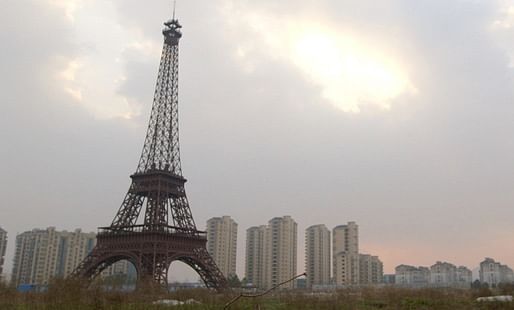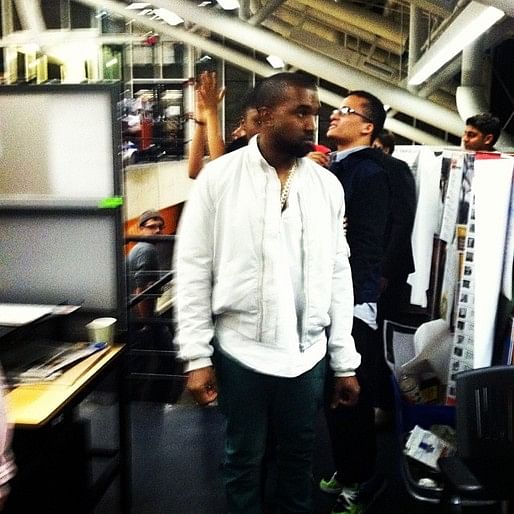
While still fresh in our minds, architecture in 2013 had as much to do with culture and technology as it did design. We saw technology’s influence expand enormously -- through design, production, clients and criticism -- simultaneously enriching and conflicting our relationship to the built environment. This surge in possibility was accompanied by an overall positive growth in the Architecture Billings Index, nearly back to pre-recession levels (as evidenced in the very high level of activity in our job board). Here is a look at the thirteen issues that dominated the field this year (in no particular order), and will inevitably color the palette of architecture in 2014.
For a full list of all of our top 13 lists for 2013, click here.
1. Pritzker's refusal to retroactively recognize Denise Scott Brown

When Denise Scott Brown called for recognition of her collaboration with husband and partner, Robert Venturi, her goal was not necessarily to be retroactively awarded the Pritzker Prize he had won in 1991, but for Pritzker to validate the notion of “joint creativity”. A petition quickly sprang up, started by GSD student-group Women In Design, appealing in support of DSB’s cause to the Pritzker award committee. Despite support from Robert Venturi and a slew of Pritzker winners, the petition did not sway the jury, and DSB was denied a retroactive award. At the very least, the AIA revised the eligibility for its highest honor, the Gold Medal, to be extended to partners in practice.
2. Fight to save Chicago's Prentice Hospital

Attempts to save Bertrand Golderg’s Prentice Women’s Hospital from demolition began in 2012, after Northwestern University announced it wanted to replace the building with a new structure. This year, preservationists fought to save the building in the face of Chicago mayor Rahm Emanuel support of Northwestern’s decision, but were eventually overwhelmed. After the building was demolished this October, Northwestern moved on to decide which firm would design the replacement structure, blacklisting firms that had protested the project. In December, Chicago-based firm Perkins+Will was selected to design the new research facility.
3. Apple's Foster-designed "spaceship" campus

After we broke the news that Norman Foster had been chosen to design Apple’s new campus on the old HP grounds in Cupertino, the first renderings surfaced way back in June 2011, a few months before Steve Jobs’ death. The design was immediately likened to a space ship, and met with predictably-polarized criticisms passing blame onto Apple, rather than Foster + Partners. This year, the conversation widened considerably, encompassing issues beyond the building’s design details and into the controversial development strategies of Silicon Valley and its impact on regional economies. Local governments are being criticized for allowing the interests of tech companies to dictate far too much of urban planning, whether it’s pricing people out of affordable rents in downtown San Francisco or handicapping mass transit infrastructure with private charter buses.
Cupertino approved the space-ship in October, while Foster + Partners continues recruiting architects for the project with job ads on Archinect. But while Apple’s roots dig deeper into Silicon Valley, the trend may point towards tech giants setting up shop in urban centers like San Francisco, as younger tech workers increasingly prefer to live in cities rather than the Valley’s suburbs, and their recruiters follow suit.
4. 3D Printing

We reported on countless 3d printing technologies, as the medium became far more accessible, affordable, and versatile in 2013, largely thanks to the expiration of select patents that were hindering developments. This year we saw the world’s first 3d printed architectural structure, advances in software and applications from MIT, use with mobile technologies, and large companies like eBay and Staples opening 3d printing options to their user-base. Oh, and material applications exploded -- you can now 3d print things out of sugar. Responses to this new technology aren’t universally positive, but the possibilities are undeniably exciting.
5. Free Cooper Union

Cooper Union’s devastating decision to start charging both graduate and undergraduate students tuition came to a sharper head in 2013. Following student protests, which included painting the hallowed halls black and occupying the Foundation Building, a tentatively agreed upon “working group” committee was established to resolve Cooper’s financial straits without charging tuition. Still, at this point, the school will go ahead with its decision to charge incoming students, provoking current School of Architecture students to launch the “One Year Fund”, a grass-roots attempt to raise enough money to compensate the entire incoming class’ first year of tuition. The campaign will run until January 6, 2014 -- you can pledge your support here: One Year Fund
6. Zaha Hadid

2013 was a banner year for Zaha Hadid, and for all those who love bashing her. Substantially upping her starchitect appeal with designs for dollhouses, superyachts, shoes, and even opening her own design gallery, Hadid-ism has really become its own brand, while still entirely embroiled in all that provocative parametric rabble-rousing. On the CV side, her Riverside Museum in Scotland was named European Museum of the Year, she’ll be designing the 2020 Olympic stadium in Tokyo, and she secured her first NYC project for a High Line adjacent condo. But aside from hardboiled academic and urbanistic debates of parametric design, Hadid also weathered some publicity flack when her Qatar stadium, designed for the 2020 World Cup, was likened to a vagina by Jon Stewart on The Daily Show. Her response was simply annoyed, and while a lot of chuckling trolls could be heard across the interwebs, this “event” quickly went off the newsworthy radar.
7. Flint’s Flat Lot Competition results, and the issue of render vs reality

Ranked #3 in Archinect’s Top 13 Discussions for ‘13, the lackluster realization of the winning proposal for Flint Michigan’s Flat Lot competition became a sounding board for a slew of frustrations, mostly related to the medium of architectural renderings. How could something that looked so smooth turn out so rough? Fingers were pointed at the architects for being unprepared and unprofessional for not being able to live up to the image, while critics questioned the ethics of creating compelling yet completely unrealistic renderings in the first place. As digital rendering becomes more advanced, will it approximate an impossible reality and encourage impossible expectations? Or should the competition judges have known better?
8. MoMA's decision to demolish American Folk Art Musuem #FolkMoMA

After MoMA’s announcement in April that it would demolish the American Folk Art Museum (for not being aesthetically consistent with the rest of the museum complex), the architecture community was whipped into a frenzy, most vehemently opposing MoMA’s decision. Two petitions were raised alongside the inspiring preservationist tumblr #FolkMoMA, and the Architectural League demanded that MoMA reconsider. In May, MoMA handed over the design plans to Diller Scofidio + Renfro, who are (at least somewhat) sympathetic to the preservationist cause. While nothing is absolutely certain, this seems like a soft win for those protesting MoMA’s decision.
9. China

China attracted lots of architectural attention this year, newsworthy events tending towards the sensationalist and the just plain whacky. Striving to hit yet another 7-8% annual growth rate under its five-year plan, China lumbered through pains of overbuilding, skyscraper binging, empty housing and ghost towns, throughout an intensifying and monstrous pollution problem. As China entices more foreign architects to build in its rapidly growing cities like Shanghai, Shenzhen or Guangzhou, more attention and criticism is piled on China’s architectural image. There’s also a hefty amount of pomo weirdness, in trying to understand things like China’s “copy towns” -- to-scale replicas of other (Western) cities, like Paris (which is now a ghost town as well), Hallstat, and Manhattan -- alongside government censorship of what might have just been any old phallic-looking skyscraper. And then, in a final-quarter twist, the Chinese government issues an almost poetic, regretful report about the lack of “humanity” in its tornado of urban development. As if also being home to the world’s largest building, containing a seaside resort, Imax cinema, Olympic-sized ice rink and a Mediterranean shopping village, wasn’t “human-centered” enough.
10. Gender equality and women's rights/recognition in architecture

While it may not have taken the dramatic form of mass public-protest or social uprising, standards of gender equality in architecture were prominently tested during 2013. Alongside the Denise Scott Brown controversy, the posthumous awarding of AIA’s Gold Medal to Julia Morgan brought on a hefty load of conflicted discussions about the nature of awards and preferential treatment based on (either) sex. In a study featured in The Guardian, it was found that the number of female architects in Britain was dropping, even while female student rates were growing closer to being equivalent with males. More depressing gender-data was laid bare over on Lian Chikako Chang’s Archinect blog, with a nifty infographic for her work with the ACSA, breaking down the gender of those in leadership positions across architecture schools in the U.S. and Canada. Meanwhile, watchdog tumblr “Feminist Wall of Shame” is doing its part to show another venue of the gender-gap, looking at lecture series suffering from a gross gender-imbalance. As the architecture profession and society in general become more embedded with technology, it will be interesting to see how conversations of women in tech (accelerated by everything from Lean In to Marissa Meyer to Goldiblox) coordinate with architecture’s gender dialogue.
11. Unpaid internships

The topic of unpaid internships in architecture inevitably inspires outrage, but rarely does it lead to actual policy intervention. Responding to a particular unpaid-job posting, debates around the topic underscored the rampant competitive nature of architecture, making the depressed conclusion that unethical compensation will persist so long as there are incentives (real or imagined) to work for free, such as that Big Name recommendation letter or CV-padding. The legality of unpaid internships is also infuriatingly muddled, as what qualifies an employer to publicly advertise for unpaid work is highly inspecific to the architecture industry. How can 50-hour work weeks with a stipend worth half-minimum wage ever be justified? Responding to three high-profile class-action lawsuits filed by unpaid interns in recent years, investigative journalism non-profit ProPublica is investigating the current nature of internships in the U.S., and will hopefully include data relevant to architecture in particular.
12. Gezi Park protests in Turkey
Mass protests took place across Turkey during the summer of 2013, beginning with the demonstrations in Istanbul’s Gezi Park. One of the few remaining public green spaces in the city, Taksim Gezi Park was under threat of becoming a shopping center, and protesters reacted with sit-ins and Occupy-esque interventions. Archinect’s own editor, Orhan Ayyüce, reported passionately on the protest as it escalated to police intervention, and called for the architecture community’s solidarity with Istanbul. As a catalyst for nationwide protest, the events in Gezi Park highlighted issues of eminent domain and top-down planning measures, and generally questioned the ethics of modernist urbanism. And conversely, taken within the context of the Arab Spring and Occupy, such protests highlighted the importance of public space to political reformation.
13. Architecture's aversion to celebrity

Why does the architecture world cringe whenever a celebrity gets involved? At mere mention of a celebrity+designer collaboration, such as Pharrell Williams’ hint at a project with Zaha Hadid or Brad Pitt’s furniture design, exclusionist rhetoric and fear of professional “dilution” kicks in, begging that “design be left to the designers”. While not always negative, reactions to celebrity-interventions tend towards the hyper-critical, oscillating between “the profession can only benefit from high-profile exposure” and “these celebrities are compromising our design integrity”. Such reactions ran rampant after Kanye West visited the GSD this past November. Perhaps this all stems from the unfortunate invention of the “starchitect” -- a heavily maligned term that casts architects as prima donnas and perpetuates the myth of individual creativity -- pushing the architecture community to reject any association with celebrity in hopes of dispelling negative stereotypes of their own profession.
Click here for Archinect's full 13 Top 13 for '13 list!
7 Comments
dear Amelia, and archinect--great summary of a set of issues that definitely shaped the conversation this past year, and happy to see gender discussions so well-represented on the list. too bad, though, that the chinese piece had to be led an image of a girl bending over in a mini-skirt. some googling tells me where it came from, but i see no need to point there.
Good point aml. That image was taken from this article we published back in April. We've changed the image.
great, thanks so much for the speedy response!
Good list but i am surprised to see gender issues highlighted but the lack of ethnic diversity, especially in design schools, ignored. It would seem that the real issue is white male privilege. -- Also, CO2 has hit 400 parts per million but sustainability is missing from the list. I know its not hip to be into sustainability but at some point, probably too late, architects will finally mobilize to address this very real threat.
Actually, architects are addressing global warming, it's just not hip enough to get a lot of coverage in the mainstream architectural press. As for the lack of ethnic diversity, I think that's a matter of time. Architecture has always favored upper class connected people, but more and more those people include minorities.
Thank you , a well written summary.
Good list. I would have added the soap opera surrounding the Eisenhower Memorial design by Frank Ghery.
Block this user
Are you sure you want to block this user and hide all related comments throughout the site?
Archinect
This is your first comment on Archinect. Your comment will be visible once approved.